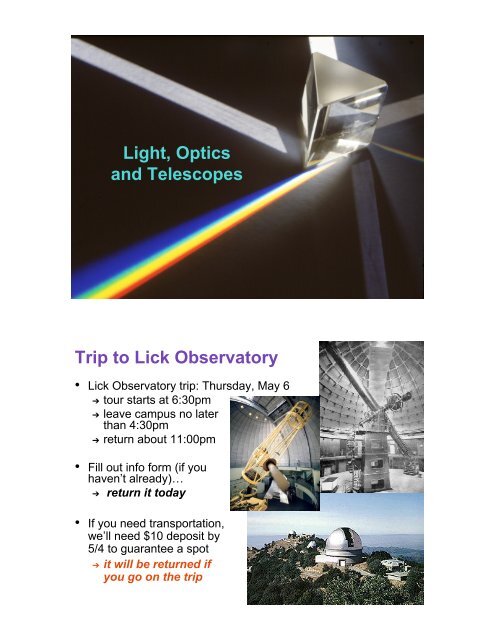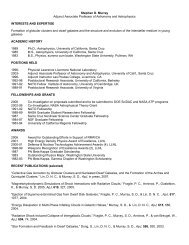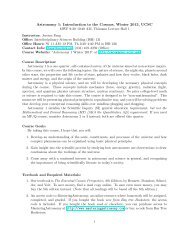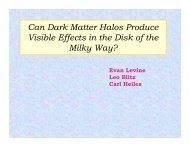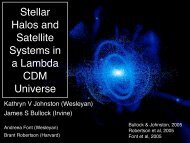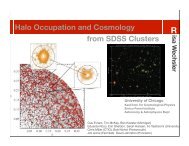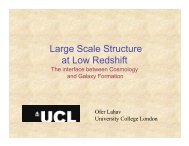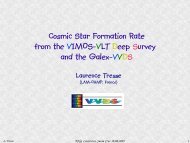Light, Optics and Telescopes Trip to Lick Observatory
Light, Optics and Telescopes Trip to Lick Observatory
Light, Optics and Telescopes Trip to Lick Observatory
Create successful ePaper yourself
Turn your PDF publications into a flip-book with our unique Google optimized e-Paper software.
<strong>Light</strong>, <strong>Optics</strong><br />
<strong>and</strong> <strong>Telescopes</strong><br />
<strong>Trip</strong> <strong>to</strong> <strong>Lick</strong> Observa<strong>to</strong>ry<br />
• <strong>Lick</strong> Observa<strong>to</strong>ry trip: Thursday, May 6<br />
! <strong>to</strong>ur starts at 6:30pm<br />
! leave campus no later<br />
than 4:30pm<br />
! return about 11:00pm<br />
• Fill out info form (if you<br />
haven’t already)…<br />
! return it <strong>to</strong>day<br />
• If you need transportation,<br />
we’ll need $10 deposit by<br />
5/4 <strong>to</strong> guarantee a spot<br />
! it will be returned if<br />
you go on the trip
Next few classes…<br />
• This week’s labs…<br />
! in Nat. Sci. II Room 110/190 (just around the corner)…<br />
! bring your telescope kit<br />
!<br />
• Thursday’s class -- more telescope observing…<br />
! meet at 7:30pm at the Porter Squiggle<br />
! some of the same object’s as last week (be there if you<br />
didn’t h<strong>and</strong> in observations <strong>to</strong> Corey last week)<br />
! some new ones<br />
• Next Tuesday’s lab<br />
! make up missed labs<br />
How we see:<br />
• We see an object when light from the object reaches our<br />
eyes.<br />
• Either because the object emits light...<br />
! the Sun, a star, a light bulb<br />
• Or because the object reflects light<br />
! the Moon, the planets, your desk
Eyes <strong>and</strong> brain process information<br />
• We figure out where an object is<br />
! from the direction light enters the eye...<br />
• We get color information from the light's wavelength<br />
• An object appears red if it emits red light (a traffic light…)<br />
! or if it reflects red light (an apple).<br />
Why is the sky blue…<br />
• It’s not that air has a bluish glow…<br />
• Air molecules scatter sunlight, particularly blue parts of the<br />
spectrum.<br />
• Blue light reaches us<br />
from all directions.
At sunset, even more “reddening”…<br />
In space the sky is dark…
The electromagnetic spectrum<br />
• “White” light contains a<br />
mixture of colors…<br />
! similar <strong>to</strong> that in sunlight.<br />
• Our eyes are insensitive <strong>to</strong> most of the electromagnetic<br />
spectrum.<br />
Early studies of light…<br />
• Showed that it traveled at a finite speed…<br />
! Galileo tried <strong>to</strong> demonstrate this with lanterns<br />
! Olas Roemer succeeded with Jupiter’s moons<br />
• New<strong>to</strong>n developed a “particle” theory of light<br />
• Christian Huygens developed a “wave” theory<br />
! light waves analogous <strong>to</strong> sound waves<br />
In fact, they were both right…
<strong>Light</strong> as a wave…<br />
• <strong>Light</strong> has wave-like properties…<br />
! diffraction<br />
! interference<br />
Pho<strong>to</strong>ns: light as a particle<br />
• <strong>Light</strong> has particle-like properties…<br />
! travels in straight line<br />
! <strong>and</strong> “bounces”<br />
! i.e. reflects<br />
! transfers energy in discrete “quanta”<br />
Pho<strong>to</strong>electric Effect: blue<br />
pho<strong>to</strong>ns knock electrons<br />
off metal; red pho<strong>to</strong>ns don’t,<br />
even lots of them.<br />
diffraction of<br />
water waves<br />
diffraction of light
Wave fronts <strong>and</strong> light rays<br />
• Waves travel circularly<br />
(spherically) from source<br />
! light “rays” show<br />
direction of travel<br />
• If source is distant…<br />
! wavefronts are flat<br />
! light rays are parallel<br />
Why are distant objects hard <strong>to</strong> see?<br />
• They are faint<br />
! light spreads out as it<br />
travels from source<br />
• They are small<br />
! angular size is small
The spectrum, again<br />
• Different regions of the spectrum….<br />
! have different wavelengths…<br />
! have pho<strong>to</strong>ns that carry different amounts of energy<br />
A look at the eye…<br />
• <strong>Light</strong> enters through the pupil...<br />
! is focused by the lens...<br />
! on<strong>to</strong> the retina.<br />
• <strong>Light</strong> entering at different angles<br />
is focused in different places.<br />
• The information your brain gets is<br />
! wavelength(s)<br />
! direction
Cameras <strong>and</strong> telescopes<br />
• Cameras are the simplest “artificial” eyes...<br />
! film takes the place of your retina...<br />
• <strong>Telescopes</strong> can be thought<br />
of as large cameras...<br />
! bring light <strong>to</strong> a focus...<br />
! on some sort<br />
of detec<strong>to</strong>r...<br />
• As in eye, light entering from different angles…<br />
! is focused in different places on detec<strong>to</strong>r<br />
Lenses <strong>and</strong> mirrors<br />
• Lenses <strong>and</strong> curved mirrors described by focal length<br />
! distance from for parallel light rays <strong>to</strong> come <strong>to</strong> a focus<br />
f f<br />
! For both: more curved = shorter focal length<br />
• Telescope optics (without eyepiece) also have focal length<br />
! (effective) distance from primary mirror/lens <strong>to</strong><br />
location of focal point
<strong>Telescopes</strong> for visual observing…<br />
• If your eye is the “detec<strong>to</strong>r”…<br />
! optics need <strong>to</strong> be more complicated<br />
• Eyepiece lens makes<br />
light rays parallel again…<br />
! your eye will<br />
focus them on<br />
retina<br />
Refrac<strong>to</strong>rs<br />
• Use a lens for primary focusing<br />
of light…<br />
• Many backyard<br />
telescopes are<br />
refrac<strong>to</strong>rs…<br />
! but its hard<br />
<strong>to</strong> make<br />
large ones
Reflec<strong>to</strong>rs<br />
• Use mirror for primary focusing of light…<br />
New<strong>to</strong>nians, Cassegrains, etc<br />
• Much jargon surrounding ways of arranging focus <strong>and</strong><br />
detec<strong>to</strong>rs…<br />
prime focus<br />
New<strong>to</strong>nian<br />
Cassegrain
Catadioptrics<br />
• Use combination of lenses <strong>and</strong> mirrors…<br />
! Schmidt-Cassegrain<br />
! Maksu<strong>to</strong>v-Cassegrain<br />
• Design allows construction of compact<br />
telescopes with long<br />
focal lengths<br />
• Which allows for<br />
! high magnification<br />
viewing<br />
! high resolution imaging<br />
• xx<br />
An optical telescope A radio telescope
Telescope mounts:<br />
• Alt-Az<br />
! azimuth axis points <strong>to</strong> zenith<br />
! altitude axis parallel <strong>to</strong> horizon, usually east west<br />
" mechanically simple, intuitive <strong>to</strong> point<br />
! for tracking need two mo<strong>to</strong>rs, computer<br />
! a camera will turn compared <strong>to</strong> sky<br />
• Equa<strong>to</strong>rial (a.k.a. “polar”)<br />
! “hour-angle” axis points <strong>to</strong> (north) pole<br />
" allows tracking with one simple mo<strong>to</strong>r<br />
" camera will turn in same way sky does<br />
! declination axis is parallel <strong>to</strong> equa<strong>to</strong>r (east-west)<br />
! mechanically difficult<br />
(the late) alt-az mounted 300ft<br />
Green Bank WVa<br />
polar mounted 140ft<br />
Green Bank WVa
Imaging: what you care about<br />
• Aperture size: light collecting area<br />
! larger diameter telescopes can see fainter objects<br />
• Angular resolution: how much angular detail you can see<br />
! larger telescopes have better angular resolution<br />
! but blurring by sky is usually the limiting fac<strong>to</strong>r<br />
• Field of view: how much of the sky you can see at once<br />
! depends on design of telescope (“plate scale”)<br />
! size of your detec<strong>to</strong>r<br />
Large telescopes collect more light…<br />
• Telescope funnels light <strong>to</strong> camera<br />
! the larger the aperture, the more light collected<br />
35mm camera at<br />
“prime focus” on<br />
a Schmidt-Cassegrain<br />
telescope
<strong>and</strong> have better resolving power…<br />
• <strong>Light</strong> passing through any opening is<br />
bent slightly…<br />
• Which makes images slightly fuzzy<br />
! instead of a pin-point dot<br />
! you get a wide dot <strong>and</strong> rings<br />
• This limits angular resolution<br />
Angular resolution<br />
• The smallest angular separation a telescope can measure<br />
! its ability <strong>to</strong> see detail<br />
low angular resolution high angular resolution
Diffraction limit<br />
• Diffraction limit: best<br />
possible angular resolution<br />
of a telescope<br />
radio telescopes<br />
need <strong>to</strong> be very<br />
large for good<br />
! wavelength of radiation: angular resolution<br />
shorter gives better<br />
angular resolution<br />
! aperture size: larger gives better<br />
angular resolution<br />
• Depends on…<br />
• Diffraction limit of telescope of diameter D :<br />
! angular diameter of central “maxima”<br />
(dot) of diffraction pattern: " # 70° ($ / D)<br />
Field of view…<br />
1000-foot Arecibo telescope<br />
• For imaging, how much of the sky you can see is set by…<br />
! “plate-scale” of telescope<br />
! depends only on focal length<br />
! arcseconds of sky per millimeter of film/detec<strong>to</strong>r<br />
! S= 206265/f mm<br />
! size of film, pho<strong>to</strong>graphic plate,<br />
or detec<strong>to</strong>r
Visual observing: what you care about<br />
• Aperture size: light collecting area<br />
! larger diameter telescopes can see fainter objects<br />
• Magnification: how much larger object appears through<br />
eyepiece than <strong>to</strong> naked eye<br />
! depends on design of telescope <strong>and</strong> eyepieces<br />
! changing eyepieces changes magnification<br />
• Field of view: how much of the sky you can see at once<br />
! depends on design of telescope <strong>and</strong><br />
Large telescopes collect more light…<br />
• Telescope funnels light <strong>to</strong> <strong>to</strong> your eye<br />
! the larger the aperture, the more light collected
<strong>Telescopes</strong> magnify…<br />
• View through eyepiece…<br />
! increases apparent angular size of object <strong>and</strong> features<br />
! allowing eye <strong>to</strong> see more detail<br />
Telescope magnification:<br />
• For a telescope (or binoculars) magnification depends on…<br />
! focal length of telescope<br />
! focal length of eyepiece<br />
M = f telescope /f eyepiece<br />
• Telescope magnification changes by changing eye pieces<br />
! “low power” = long focal length (e.g. 50mm)<br />
! “high power” = short focal length (e.g. 7mm)
Telescope focal length:<br />
• Telescope focal lengths are not usually stated directly<br />
! usually via the aperture diameter<br />
! <strong>and</strong> focal ratio (ratio of focal length <strong>to</strong> aperture)<br />
• Example: Lab telescope…<br />
! aperture diameter: 10”<br />
! focal ratio: f/6.3<br />
! focal length is 10 x 6.3 = 63” = 1600mm<br />
! magnification with a 50mm eyepiece = 1600/50 = 32<br />
! magnification with a 10mm eyepiece = 1600/10 = 160<br />
• Various accessories will change telescope’s focal length<br />
! focal reducers shorten it<br />
! Barlow lenses lengthen it<br />
Field of view: visual observing<br />
• For visual observing field-of-view is set by…<br />
! eyepiece design, primarily<br />
! focal length<br />
! diameter<br />
! Magnification of telescope/eyepiece combination<br />
• Eyepieces have an apparent field of view<br />
! e.g. 50° -- full field of view of eyepiece looks like 50° <strong>to</strong><br />
your eye<br />
• True field of view<br />
! apparent view divided by magnification<br />
! e.g. 50° eyepiece <strong>and</strong> 100x magnification focal length<br />
! you can see 0.5° of sky through eyepiece
Optical telescopes <strong>and</strong> “seeing”<br />
• Angular resolution of optical telescopes on Earth is limited<br />
! by changing atmospheric refraction<br />
! not diffraction<br />
• The effect that makes stars twinkle blurs telescope images<br />
Twinkling…<br />
• Stars twinkle because…<br />
! angular size of star is very small % …<br />
! smaller than “bouncing”<br />
due <strong>to</strong> seeing<br />
• Angular size of planets is larger…<br />
! they are blurred by seeing….<br />
! but don’t seem <strong>to</strong> twinkle<br />
% Stars look point-like through a telescope even with very<br />
high magnification
Better seeing in space<br />
• Best seeing on Earth is a fraction of an<br />
arcsecond<br />
• Even small telescopes in space<br />
are useful<br />
Adaptive <strong>Optics</strong><br />
• Astronomers now try <strong>to</strong> track<br />
atmospheric wobbling...<br />
! with fraction-of-a-second images...<br />
! <strong>and</strong> artificial guide stars...<br />
2.4m HST
More atmospheric problems…<br />
• Many wavelengths can only be observed from space…<br />
! ultraviolet<br />
! x-ray<br />
! gamma-ray<br />
! many infrared wavelengths<br />
• The atmosphere doesn't just blur these wavelengths...<br />
! it absorbs them.<br />
Next week: Observing Stars<br />
• Parallax <strong>and</strong> distance measurements<br />
• The magnitude scale<br />
• Spectra, <strong>and</strong> what you can learn from them


